4-Day Weekend in Malta: Centuries-Old Architecture and Mediterranean Cuisine
This Mediterranean archipelago is a unique destination where Italy, England, North Africa, and more meet to create a true cultural melting pot.
In early fall when the sun begins to dip, Valletta bakes brown from its hilly perch atop deep blue waters. Small cars pinch through still smaller streets built for a time when Malta, Europe’s tiniest and southernmost capital, was the home to the Knights of Malta—a religious and military order pledged to protect the Holy Land. The harbors on either side spread into deeper and deeper blues. Ornate and colorful closed wooden balconies, known as "gallariji," protrude overhead and cats lap at tinned fish left atop any of the city’s centuries-old staircases.
From dizzying limestone cliffs and hidden coves with red sand beaches to a five-century-old capital and a party district that could test the limits of the Vegas Strip, Malta offers something for everyone. Those yet to visit the tiny Mediterranean archipelago might point to the nation’s “lenient” banking laws as its salient trait, but peek behind the curtain and you’ll find one of the most unique destinations on the planet, where Italy, England, North Africa, and more meet to create a true cultural melting pot.
Located between Sicily, Tunisia, and Libya, Malta is made up of 21 islands of which only the three largest are inhabited. A British colony until 1964, the national languages are English and Maltese, and 66 percent of the population also speaks Italian. While Malta may be the world’s 10th smallest country by area, a four-day stay will only allow you to scratch the surface of this diverse nation.
Related: Hoi An Vietnam 4-Day Travel Guide
How to Get to Malta
Your best options are to go through Rome or Barcelona, both of which offer flights throughout the day. The flight from Barcelona is about two hours, while from Rome it's a little less than one and a half. There’s also a daily ferry from Sicily.
Where to Stay in Malta
Unless you’re in Malta solely to party, you’ll want to stay in the capital, Valletta. Located on the southeastern side of the main island, the city gives the best access to the nation’s robust bus and boat systems that make accessing any part of the country a cinch. As long as you’re inside the city gates, everything within Valletta is a short walk away.
Rosselli
Located a 10-minute walk from the City Gate, Rosselli combines baroque architecture with modern comforts and is one of Valletta’s only five-star hotels. Every room is air-conditioned—a must—and equipped with a flat screen TV, while the building itself was built in the 17th century and formerly owned by a member of the Knights of Malta. A continental breakfast with fresh fruit is available daily, while the Michelin-starred restaurant features a sophisticated menu and dessert selection.
Casa Ellul
This former 19th-century palazzo captures the beauty of a traditional Valletta townhouse, while also offering the contemporary amenities modern travelers expect. There are only nine suites available inside Casa Ellul, all uniquely designed. If you’re looking for your own private rooftop terrace, be sure to book Suites 6, 7, or 8. The hotel is just a 10-minute walk past the City Gate and five minutes from St. John's Co-Cathedral.
The Cumberland
Offering 23 uniquely-styled rooms about five minutes from the City Gate and catty-corner to St. John’s Co-Cathedral, The Cumberland mixes the elegance of its 16th-century palazzo setting with modern comforts. There’s a rooftop deck with expansive views of the Grand Harbour, while the hotel restaurant, Grana, offers a wide variety of options for breakfast, lunch, and dinner.
Related: 4-Day Weekend in Quito
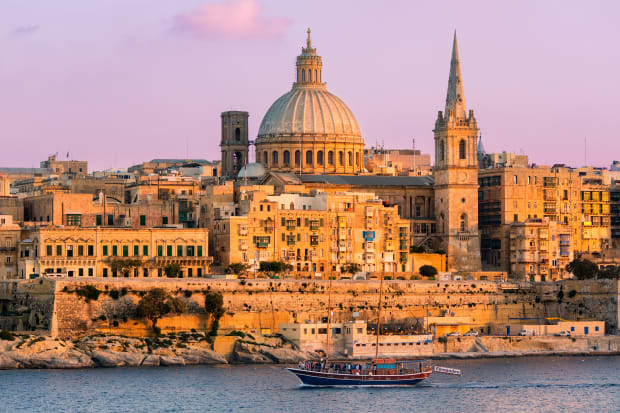
Getty
Day 1 - Valletta
If you fly overnight and get to Barcelona bright and early, you should be able to catch a morning flight to Malta—and you'll have already gone through customs. After dropping off your bags, it’s time to explore the beautiful capital just outside your hotel door.
Lined with ancient streets made of brown stone and centuries-old cafes, Valletta is essentially an outdoor museum. A UNESCO World Heritage Site since 1980, the city boasts 320 monuments within an area under a square quarter mile, making it one of the most concentrated historic areas on the planet. The city’s first stone was placed in 1566 and was mostly finished by the mid-1570s, thanks to help from Pope Pius V and many of Europe’s richest and most powerful houses, including Philip II of Spain.
Start at the historic but evolving City Gate at the entrance to the city. First built in 1569, the gate is now on its fifth edition, built between 2011 and 2014 and designed by Italian architect Renzo Piano. By looking over the edge on either side, you’ll begin to understand the fortified nature of the city and how it came to be a prized possession of various kingdoms over the last five centuries.
Next up, St. John's Co-Cathedral. Imagine the most ornate church you’ve ever walked inside and then dip it in gold and fill its exterior buildings with Caravaggio paintings and you’ll have a rough idea of what to expect from this must-see. It costs €15 for adults to enter and €7.50 for students and seniors.
Related: Best Carry-on Luggage, Backpacks and Duffel Bags
Head over to the northside of town for a late lunch at 67 Kapitali, Malta’s best spot for craft beer lovers. The menu is filled with sandwiches, soups, and salads, but we suggest choosing one of their bespoke platters, which should be shared between a minimum of two people.
Now properly satiated, it's time to enjoy your afternoon in the peaceful grounds of the Upper and Lower Barrakka Gardens. Open from 7 a.m. until 10 p.m. and perched atop the Grand Harbour, the colonnaded Upper Barrakka Gardens offer some of the most impressive views on the island. Built in 1661, these were the private gardens of the Knights Hospitaller until opened to the public in 1824. The Lower Gardens are located just a 15-minute walk from their Upper twin and positioned to watch ships come and go through Grand Harbour. These lower gardens tend to be significantly less crowded, making them an excellent spot to relax after a busy day.
For dinner, indulge in some traditional Maltese food at Il-Horza, a local favorite restaurant tucked on an old, narrow street near the Grand Harbour. Dishes are made with local ingredients and portions are generous. If you truly want to get into the Maltese spirit, we recommend going with the rabbit, a local favorite you’ll find on many menus across the island.
If you’re looking for an after-dinner drink, stop by Cafe Society, where seats along ancient steps with views looking out on Grand Harbour make for a truly magical setting.
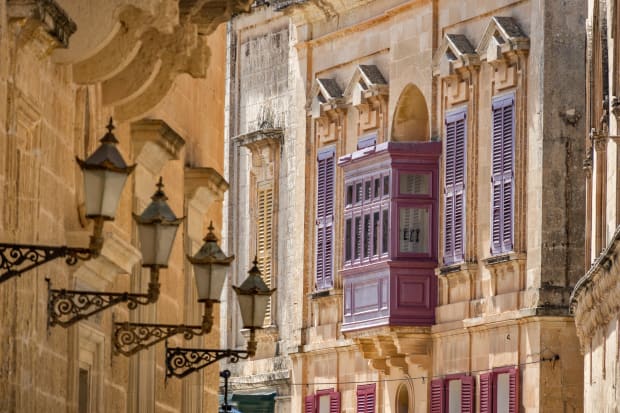
Getty
Day 2 - Mdina
Start your day with coffee and a pastry under one of the giant umbrellas at Caffe Cordina. Serving since 1837, everyone heads here for breakfast or lunch—or both. The tranquil square outside makes for a perfect place to prepare for your first day outside the City Gate. Today, you’ll be heading to Mdina.
Head through the City Gate, past the giant fountain, and down to the bus station where you can purchase a ticket to Mdina. Buses leave every 10 minutes and take about half an hour to reach the fortified Old City—or Città Vecchia in Italian. The capital of Malta from antiquity to the medieval period, Mdina remains the center of Maltese nobility and religious authorities.
Game of Thrones fans might recognize the entrance to the city, as this is where "Lord Snow," Catelyn, and Ser Rodrik Cassel rode into King’s Landing. In fact, Mdina is where much of the first season’s King’s Landing scenes were shot. Simply wander through the ancient streets and enjoy one of the best preserved ancient cities on earth.
Mdina is also a great place to pick up a souvenir, as it's known for its impressive glasswork. If you’re looking to add a few colorful pieces to your home bar, head to any of the town's numerous craft shops and pick out something that calls to you.
For lunch, head to Coogi’s, where vine covered courtyards and medieval dining rooms make for a special setting to enjoy a wide variety of dishes. You can choose from a set menu or opt for à la carte options that include everything from salads and pasta to pizza, burgers, and a variety of vegan options.
Related: The Essential Travel Clothes You Need
After lunch, grab a bus back to Valletta and prepare for another round of time travel in the capital. The city's National War Museum in Fort St. Elmo on the far side of the peninsula is one of Malta’s more popular museums, containing a variety of exhibits relating to Maltese military history dating back to the Bronze Age. Some of the most impressive exhibits recount the country’s importance during World War II.
For dinner, head to Rubino—after making sure to reserve weeks in advance. Tucked inside a former confectionery and occupying just two small rooms, Rubino is a dining institution in Malta. The warmth of family and pride in quality fill the space. Don’t be surprised if you find the owner’s family laughing and dining together in the lower room.
One of Valletta's oldest establishments, it dishes out opulent fare based on traditional Maltese and Italian traditions. The chalkboard menu changes daily, but one of the best dishes I’ve eaten anywhere was the foie gras-stuffed quail. Put your trust in the host when it comes to wine pairings and prepare for a truly spectacular meal.
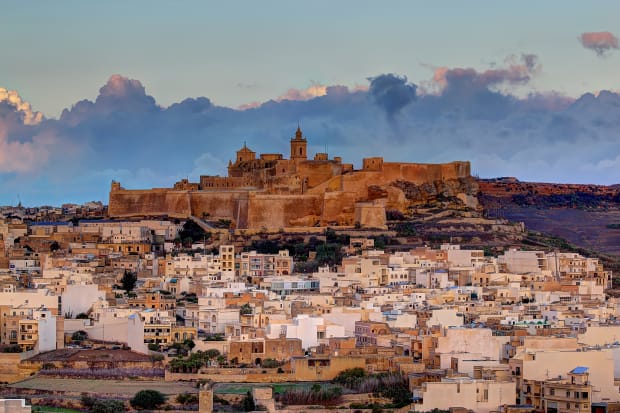
Getty
Day 3 - Gozo
These days, it's easy to reach Malta’s second largest island, Gozo, thanks to the Gozo Fast Ferry. Leaving from Lascaris Wharf Terminal in the Grand Harbour (a short walk from St. John's Co-Cathedral) the ferry travels between Valletta and Mgarr (Gozo) in less than 45 minutes. Pack a bathing suit, towel, and a change of clothes—and be advised (for the easily motion sick) that the boat moves pretty quickly and can be a bit bumpy at times.
Once in Gozo, you’ll want to get a cab. Make sure to get the driver's phone number as it’s useful to be able to call for additional rides throughout the day—often at a special day rate.
First stop is Victoria (also known as Rabat), the capital of Gozo Island. Known for its medieval citadel, this ancient fortified castle has been the center of activity on the island since around 1500 B.C. When you've had your fill of wandering through the ancient town center, call up your cab driver and get a ride to Xlendi, an enchanting urban village known for swimming and snorkeling.
In Xlendi, you can brave the concrete diving board for some high dives that border on cliff jumping. Or head to shallower waters and the small beachfront lining the town, where you'll find several good restaurants. For lunch, we recommend Terrazzo or Cima—the latter serving a pan-seared octopus simmered in garlic, white wine, and lemon that you can't go wrong with. Both dining options offer beautiful views, but reserve ahead.
If you have energy for more Malta-style time travel before heading back to Mgarr and your ferry to Valletta, it’s worth making a trip to Ġgantija, a megalithic temple complex older than the pyramids of Egypt.
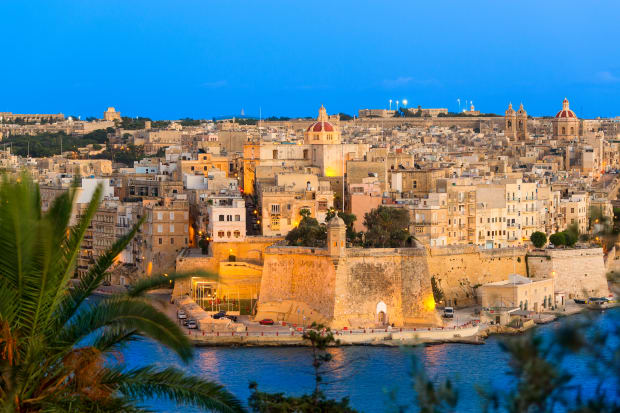
Getty
Day 4 - The Three Cities
If you planned wisely, you’ll be catching an evening flight out of Malta, giving you more than enough time to enjoy lunch and a walk around The Three Cities (Vittoriosa, Senglea, and Cospicua).
To get there, head back to where you caught the ferry to Gozo. This time you'll be boarding a water taxi—or dgħajsa—to whisk you across the harbor for a couple euros. The ride across in these long, wooden boats driven by locals takes just a few minutes and is well worth the experience.
Related: The 20 Best Solo Travel Destinations in the World
The Three Cities of Malta are basically pieces of living history that have somehow been kept alive by hundreds of years of preservation. Coming from Valletta, the first harbor inlet will be Vittoriosa, which is immediately recognizable due to all the crazy super yachts docked throughout. Have lunch on the terrace at Terrone, a waterfront restaurant nuzzled into the walls of Fort St. Angelo with great views and delicious Maltese and Southern Italian-influenced cuisine.
Nearby, Fort St. Angelo is worth exploring for history buffs. Or take a short walk to Senglea, west of Vittoriosa, to stroll the attractive Gardjola Gardens. Before returning via water taxi, enjoy exploring the charming streets of Cospicua, nestled between Senglea and Vittoriosa and filled with iconic Maltese balconies.
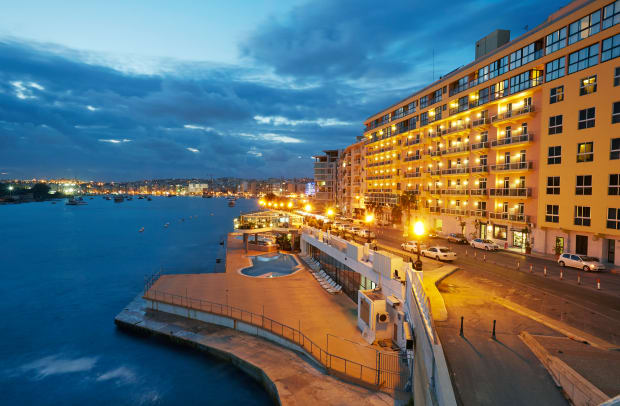
Getty
Know Before You Go
St. Julian’s and Paceville
If you’re looking for a Vegas-style party night, the seaside town of St. Julian’s is where you'll want to head. The streets of Paceville, the town’s party district, are lined with bars and nightclubs that rage deep into the night. You’ll find casinos and upscale hotels lining the coast.
Sliema
Situated between Valletta and St. Julian’s, Sliema's row of bars and restaurants line a moderately lively seaside promenade. In the blocks directly behind, you’ll find a mix of baroque churches, sidewalk cafés, and fashion boutiques. Two of the most popular bars here include The Black Sheep and The Thirsty Barber.
https://ift.tt/kLCTbUV March 31, 2023 at 10:49PM Men's Journal
Comments
Post a Comment